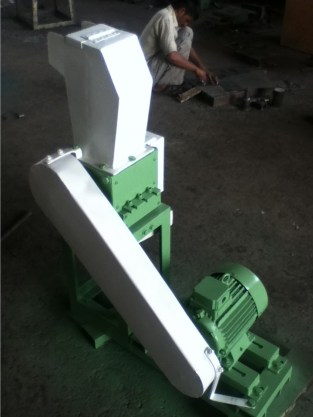I met Sidhant Pai at the 2014 3D PrintShow where he was displaying Protoprint’s 3D Printer filament made from waste-picked recycled HDPE. After the show, we discussed Protoprint’s social enterprise, company origins and the machines used to create their fair-trade 3D printer filament. – Anna Kaziunas France

What is Protoprint?

Protoprint is a social enterprise based in India that empowers urban waste pickers with the technology to convert waste plastic into 3D printer filament. The organization markets the filament globally as a price-competitive, fair-trade alternative to virgin filament while simultaneously using it locally to provide affordable 3D-printing services to students and professionals in India.
Over 12.5 million tons of plastic is consumed annually by India and almost all the segregation of the plastic occurs at the dump site, where waste pickers sift through garbage, separating the plastics from organic waste. They sell the plastic to middlemen scrap dealers but receive an extremely low amount for their important work. After spending the day trawling through trash, many of these hardworking individuals earn less than $1/day and live in impoverished conditions.
What inspired you to start a social enterprise company?
Growing up in Pune, I had a great childhood but was exposed to a lot of problems common to a developing-world environment. When I came to MIT, I was interested in the use of low-cost technology for development and worked on projects in Tanazania and Nicaragua during my first two years (Pedal Powered Butter Churn in Tanzania, Affordable Solar Cell Phone Charger in Nicaragua).

During my sophomore summer, I was looking into grassroots recycling technology to move waste pickers higher up the value chain. At the same time, my father was playing around with the idea of building a 3D printer. As we were talking one day, it struck us that the filament used by FDM printers was fairly simple to extrude. We started looking into designing low-cost extrusion machines.
How was the company formed?
Over the spring semester of the following year, I mentioned the idea to Katie Spies (an MIT classmate). She was immediately interested and joined the team. The MIT Team (Katie and I) worked in collaboration with the India team (my parents) to design and develop the ‘FlakerBot’ and ‘RefilBot’.
While we iterated on our technology, we began building a relationship with SWaCH (the waste pickers co-operative) in Pune. Last summer, we set up our pilot ‘Filament Lab’ at a dump site and began working with them on processing the waste HDPE.
Tell me more about the machines that turn waste HDPE into 3D-printer filament
The Flakerbot is a compact machine that uses a rotating 5HP shredder to ‘flake’ the HDPE bottles we put through it. The RefilBot is a compact extruding mechanism that uses a rotating screw conveyor to transport the flakes through a ‘cooking’ process that melts it before extruding it to 3mm filament. Our machines are designed to be low-cost, safe, and easy-to-use in order to better integrate with the waste pickers current supply chain.
We’re still in the process of improving the RefilBot to increase the rate of extrusion. Once completed, we’re looking at making both the process and plans available freely to others looking to adopt a similar model. Currently, we’re not looking to sell them but it may be in the cards down the line.
Tell me more about how Protoprint works with waste pickers
Protoprint’s technology enables waste pickers to convert the HDPE plastic they collect into 3D printer filament. By working collaboratively with waste picker co-operatives in India, Protoprint sets up filament production facilities at dump sites and trains the waste pickers to use the technology, enabling them to create 3D printer filament from the plastic they collect and transforming them into micro-entrepreneurs. This allows them to earn over 15 times more for the same amount of plastic, empowering them both socially and financially.

Protoprint currently has a pilot ‘Filament Lab’ set up in the city of Pune (India) where we’ve partnered with a local waste picker co-operative called SWaCH. Komal, the daughter of a waste picker herself, oversees the filament production and sources the HDPE plastic from a network of local waste pickers.
What’s next for Protoprint?
Our filament is currently produced in 5 different colors and Protoprint is using the pilot period over the next 6 months to test the filament on a number of commercial printers. We are looking at making the filament commercially available starting mid-2014 in both 3mm and 1.75mm variations.
Wealth from waste has been the waste picker motto for decades, and the team at Protoprint embraces it whole heartedly.
ADVERTISEMENT






